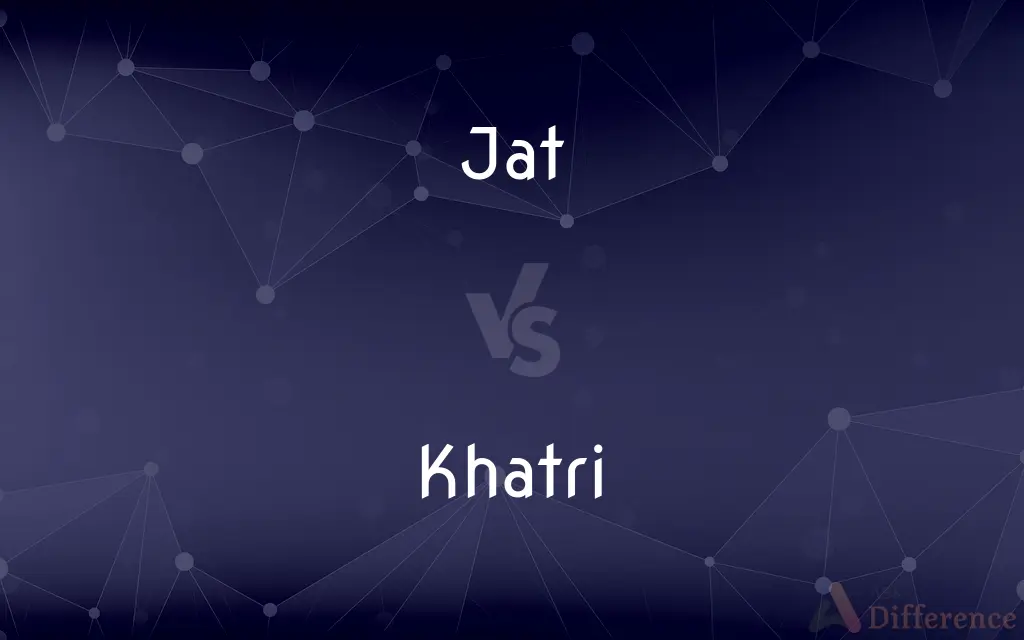Jat vs. Khatri — What's the Difference?
Edited by Tayyaba Rehman — By Urooj Arif — Updated on March 30, 2024
Jat and Khatri are distinct ethnic groups in India and Pakistan, with Jats traditionally associated with agriculture and landowning, while Khatris are known for their involvement in commerce, trade, and as skilled artisans.

Difference Between Jat and Khatri
Table of Contents
ADVERTISEMENT
Key Differences
Jats are primarily an agrarian community found in the northern regions of India and Pakistan, with a significant presence in states like Punjab, Haryana, and Uttar Pradesh. Their historical role as farmers and warriors has shaped their identity. Khatris, on the other hand, are a mercantile and artisan community, traditionally engaged in trade, business, and craftwork, predominantly found in the Punjab region of both countries.
The social organization of Jats has been traditionally linked to landownership and agriculture, making them a pivotal part of the rural economy. They have been known for their robust physical presence, which contributed to their reputation as formidable soldiers. Khatris, while also known for their bravery, have significantly contributed to the urban economy and culture, excelling in commerce, administration, and various professions.
In terms of historical significance, Jats have played crucial roles in resisting invasions and have a rich legacy of rebellion against colonial and imperial powers. Khatris have a diverse historical role that includes being prominent in the Mughal administration, as well as in the spread of Sikhism, with several Sikh Gurus coming from Khatri families.
Jats are known for their straightforwardness, strong community bonds, and martial traditions. They celebrate festivals like Holi and Lohri with great enthusiasm. Khatris celebrate these festivals too but also have distinct traditions reflecting their mercantile and urban heritage, with a strong emphasis on education and social ceremonies.
Regarding religion, Jats are predominantly Sikhs and Hindus, with a smaller number being Muslims in Pakistan. Khatris are primarily Hindus and Sikhs, with Sikhism having a profound impact on their community, particularly in shaping their social practices and religious observances.
ADVERTISEMENT
Comparison Chart
Primary Occupation
Agriculture, landowning
Commerce, trade, artisan work
Geographic Distribution
Northern India and Pakistan
Primarily Punjab region
Historical Role
Farmers, warriors
Traders, administrators
Cultural Traits
Martial traditions, community-oriented
Mercantile, urban heritage, emphasis on education
Religious Affiliation
Predominantly Sikhs and Hindus, some Muslims
Predominantly Hindus and Sikhs
Festivals Celebrated
Holi, Lohri, among others
Holi, Lohri, specific community rituals
Contribution to Society
Agricultural development, military roles
Commerce, spread of Sikhism, craftsmanship
Compare with Definitions
Jat
A traditionally agrarian community with a significant presence in North India and Pakistan.
The Jat farmers led the protest for agricultural reforms.
Khatri
Known for their role in the administration during the Mughal era.
Khatris served as administrators and ministers in Mughal courts.
Jat
Predominantly engaged in agriculture.
Jat communities are known for their advanced farming techniques.
Khatri
Have a strong presence in the Punjab region.
The Khatri festival in Punjab attracts participants from various parts.
Jat
Celebrate festivals like Holi and Lohri with enthusiasm.
The Jat family prepared traditional dishes for Lohri.
Khatri
Several Sikh Gurus were born into Khatri families.
The Khatri community takes pride in their contribution to Sikhism.
Jat
Known for their martial prowess historically.
Jats have been celebrated in folk songs for their bravery.
Khatri
A community traditionally involved in trade, commerce, and crafts.
The Khatri family has been running the textile business for generations.
Jat
Have diverse religious affiliations including Sikhism, Hinduism, and Islam.
The Jat community in the village comprises Sikhs and Hindus living harmoniously.
Khatri
Contributed significantly to the urban economy and culture.
Khatris have been at the forefront of establishing trade networks.
Jat
A member of a peasant caste residing in the Punjab and other areas of northern India and Pakistan, comprising Muslim, Hindu, and Sikh groups.
Khatri
Khatri is a caste, originally found in South Asia. Apart from India, they are also found in Afghanistan and Pakistan.
Jat
Alternative spelling of yat
Jat
A member of an Indo-European people widely scattered throughout the northwest of the Indian subcontinent and consisting of Muslims and Hindus and Sikhs
Common Curiosities
Can you describe a cultural difference between Jats and Khatris?
Jats have a martial and community-oriented culture, celebrating festivals with enthusiasm, while Khatris have a mercantile culture with an emphasis on education and social ceremonies.
How do Jats and Khatris contribute to their societies?
Jats contribute through agriculture and military roles, while Khatris impact commerce, the spread of Sikhism, and craftsmanship.
What are the main professions of Jats and Khatris?
Jats are traditionally involved in agriculture and landowning, while Khatris are engaged in commerce, trade, and artisanal work.
How did the Khatris influence Sikhism?
Several Sikh Gurus came from Khatri families, and the community played a vital role in the religion's spread and practices.
Where are Jats and Khatris predominantly found?
Jats are found in northern India and Pakistan, with a concentration in Punjab, Haryana, and Uttar Pradesh. Khatris are primarily located in the Punjab region.
Do Jats and Khatris share the same religious beliefs?
Both communities include Sikhs and Hindus primarily, with some Jats in Pakistan being Muslims.
Are there any notable festivals specific to Jats or Khatris?
Both communities celebrate festivals like Holi and Lohri, but Khatris also have specific community rituals reflecting their mercantile heritage.
What is the significance of martial tradition among Jats?
The martial tradition underscores the Jats’ historical role as soldiers and their significant contribution to military efforts across history.
What are the educational values in Khatri families?
Education is highly valued among Khatris, reflecting their traditional roles in commerce and administration where literacy and numeracy are important.
Have Jats and Khatris played any historical roles?
Jats have a history of resistance against invasions and colonial powers, while Khatris have been involved in trade, administration, and played a significant role in the spread of Sikhism.
Share Your Discovery

Previous Comparison
Sisal vs. Henequen
Next Comparison
Rock vs. DiscoAuthor Spotlight
Written by
Urooj ArifUrooj is a skilled content writer at Ask Difference, known for her exceptional ability to simplify complex topics into engaging and informative content. With a passion for research and a flair for clear, concise writing, she consistently delivers articles that resonate with our diverse audience.
Edited by
Tayyaba RehmanTayyaba Rehman is a distinguished writer, currently serving as a primary contributor to askdifference.com. As a researcher in semantics and etymology, Tayyaba's passion for the complexity of languages and their distinctions has found a perfect home on the platform. Tayyaba delves into the intricacies of language, distinguishing between commonly confused words and phrases, thereby providing clarity for readers worldwide.














































